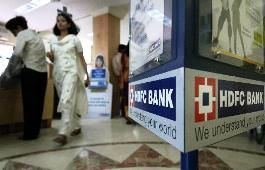 | « Back to article | Print this article |
 HDFC Bank has been growing its advances faster than the banking system for several years now.
HDFC Bank has been growing its advances faster than the banking system for several years now.
In an interview with Manojit Saha and Somasroy Chakraborty, executive director Paresh Sukthankar says the bank is adequately capitalised to meet the growth targets for at least a couple of years. Edited excerpts:
The Reserve Bank of India has expressed concerns regarding the widening gap in loan and deposit growth. As of December-end, your deposit growth was 22 per cent. What is your credit-deposit ratio? Have you taken any step to limit the rise?
The principle behind looking at the credit-deposit ratio is to find out if the bank has sufficient liquidity to support its loan growth.
There are two ways to look at it -- in terms of absolute liquidity and the composition of the same.
Sometimes, the ratios are high as you have a higher capital. Normally, better-capitalised banks have high credit-deposit ratios.
If the ratio is high due to high capital, it is better than having a lower credit-deposit ratio. Our ratio for domestic operations currently stands at 77 per cent.
As far as the industry is concerned, do you think the incremental growth in credit-deposit ratios will remain high?
Higher deposit rates have led to faster growth in deposits.
To that extent, loan rates have also gone up. Given the high base of loans in March last year, the loan growth of 23-24 per cent in the system may come down to 21-22 per cent by year-end.
Also, growth in deposits has gone up from 14-15 per cent to 17-18 per cent.
Thus, the gap of 500-600 basis points between deposit and loan growth will narrow down to 200-300 basis points.
Naturally, the incremental growth in credit-deposit ratios will also moderate.
During the present liquidity crunch, most banks scrambled for funds to support loan growth. How was your experience?
I will call it liquidity deficit and not a crunch as it did not create panic in the market.
If you look at the banking system's net borrowing and the wholesale price index numbers, peaks in both segments happened in the earlier part of the year.
However, as there was a feeling that inflation will come down by the end of the year